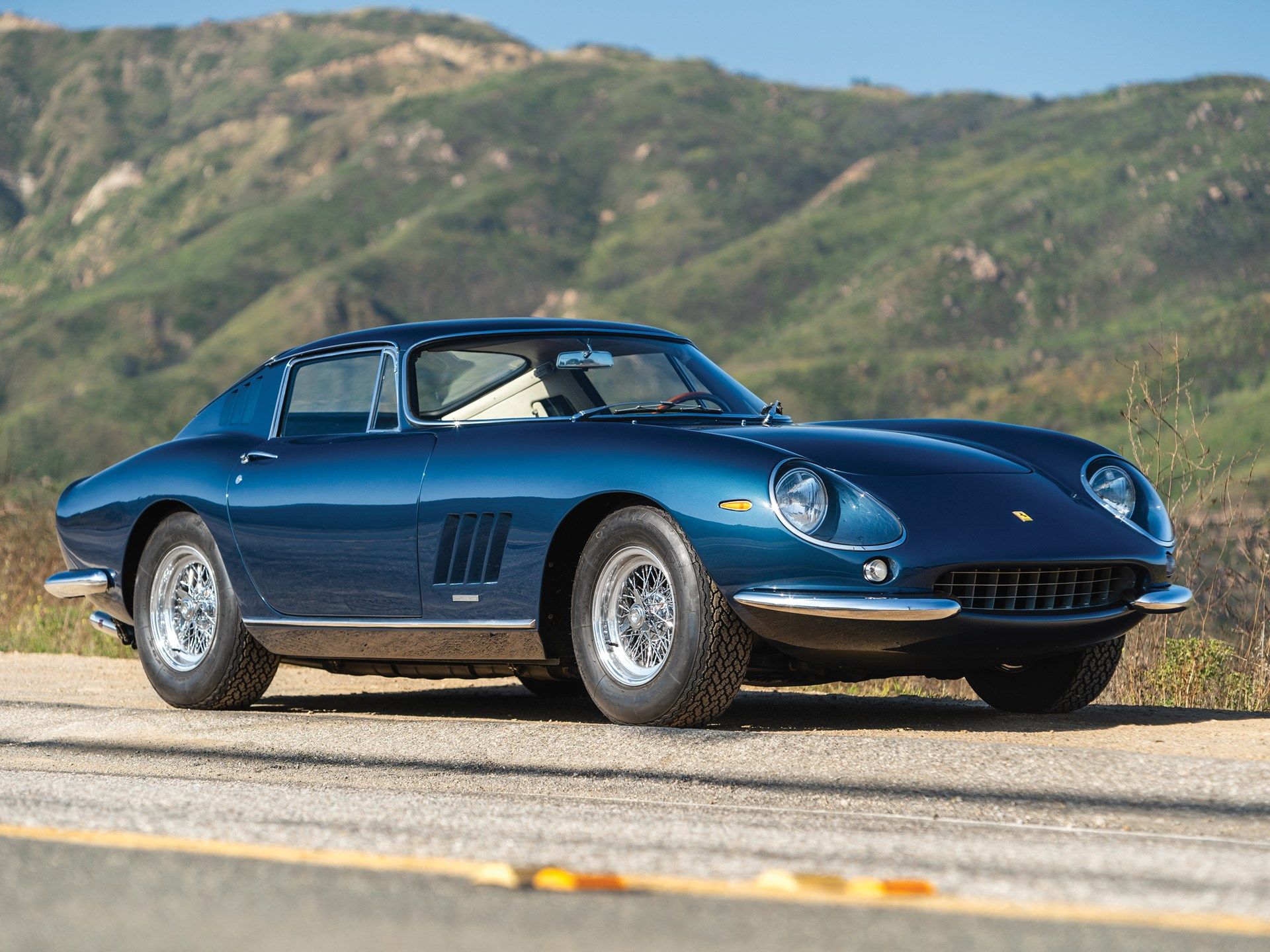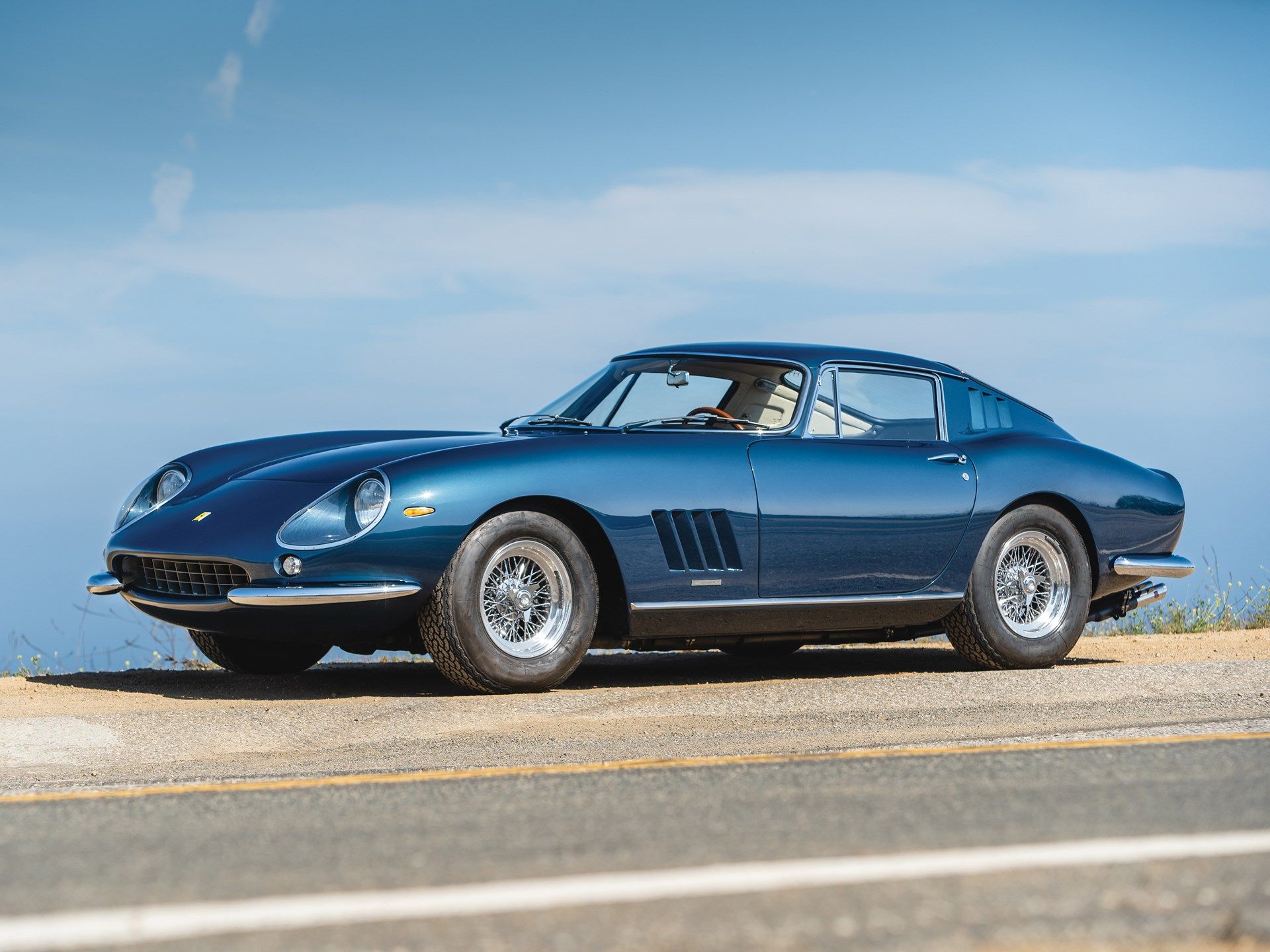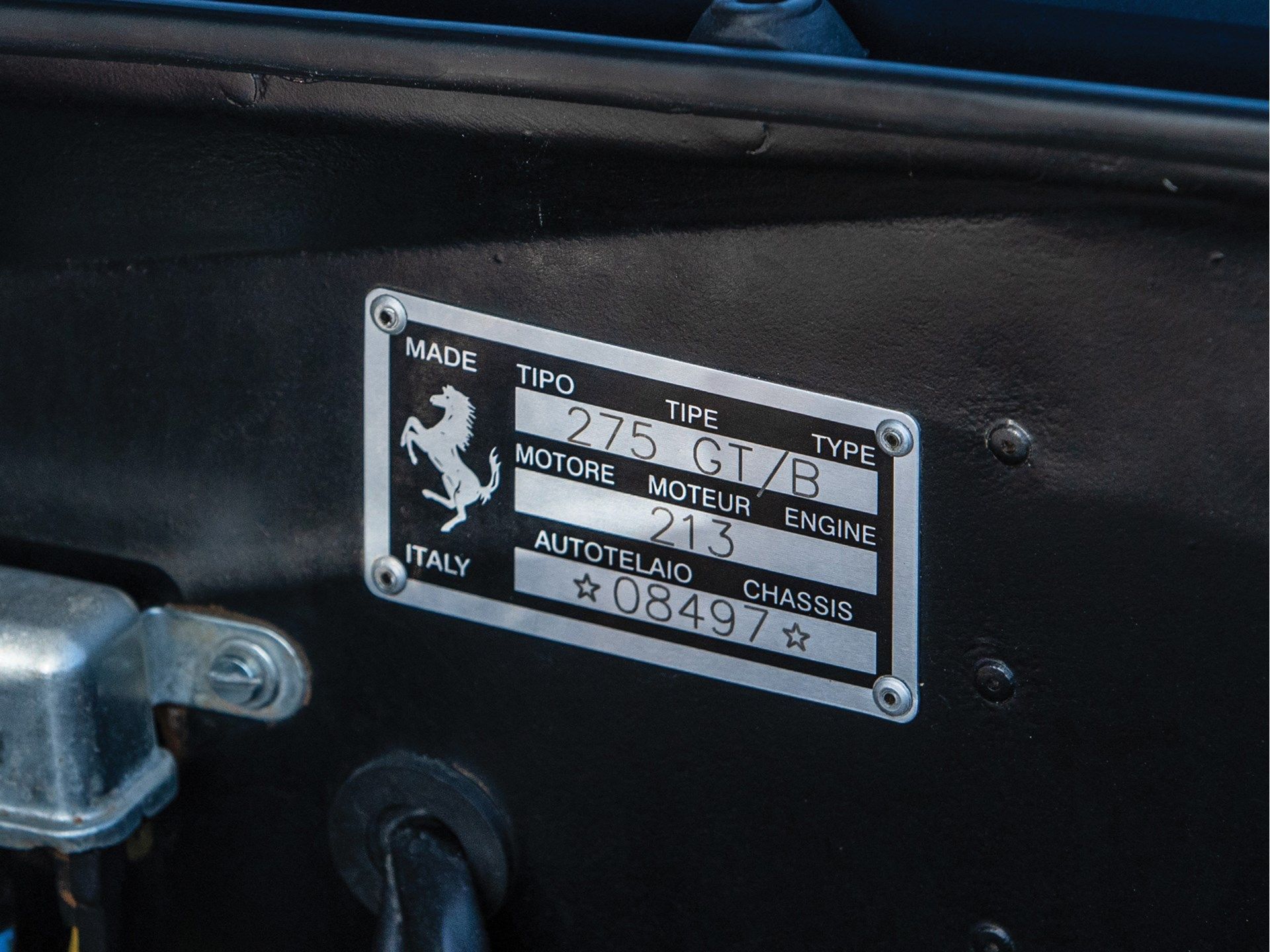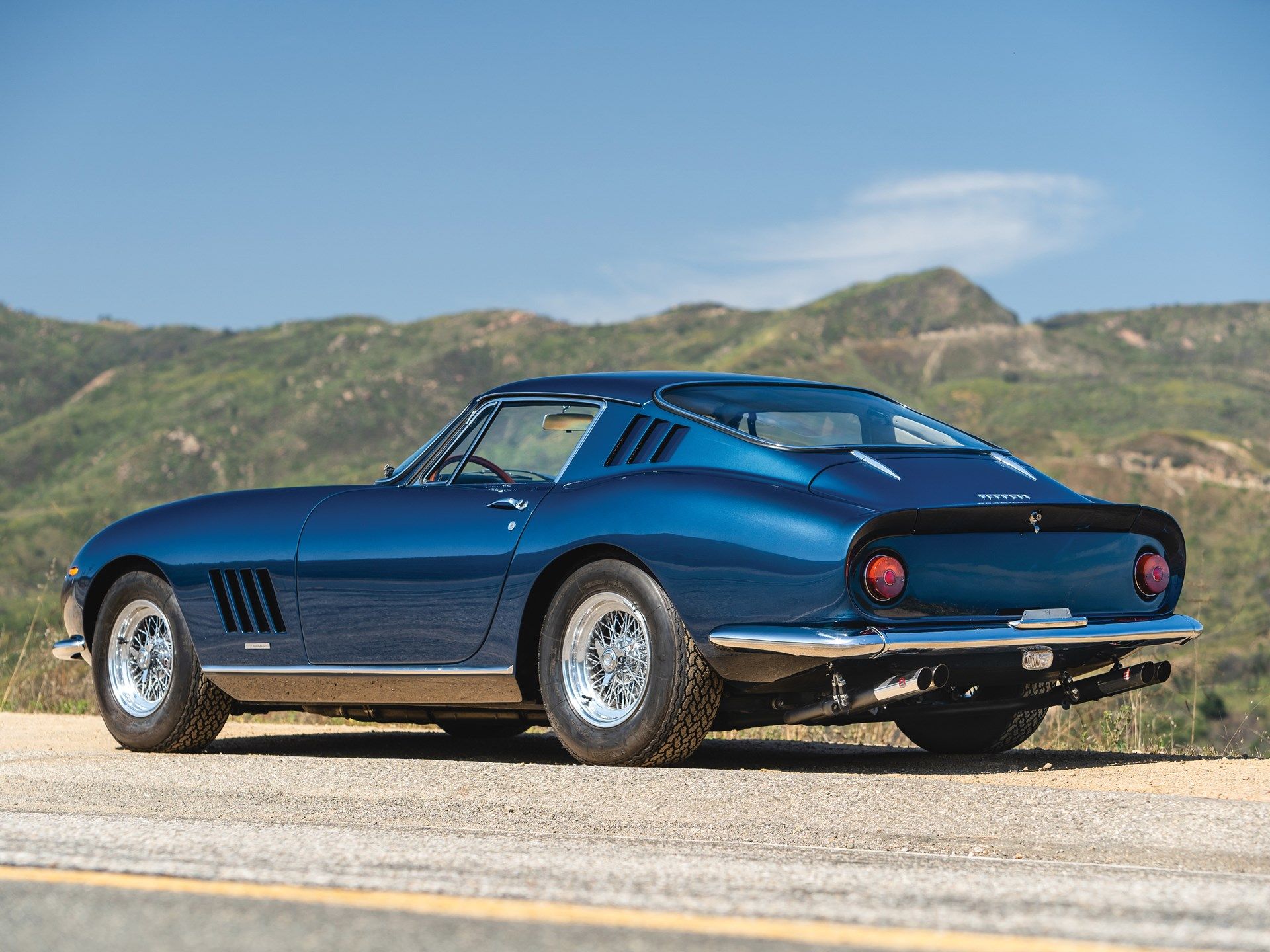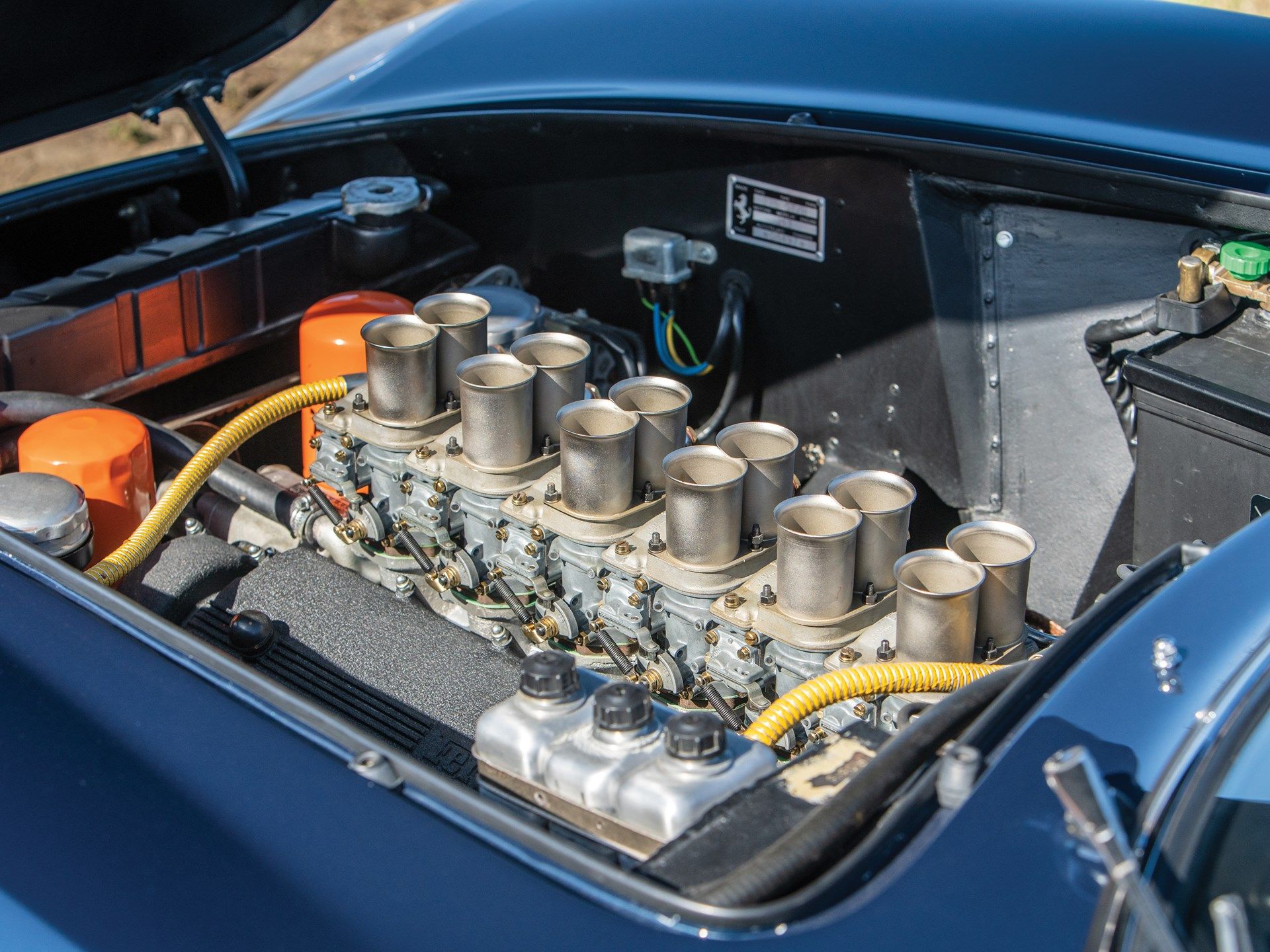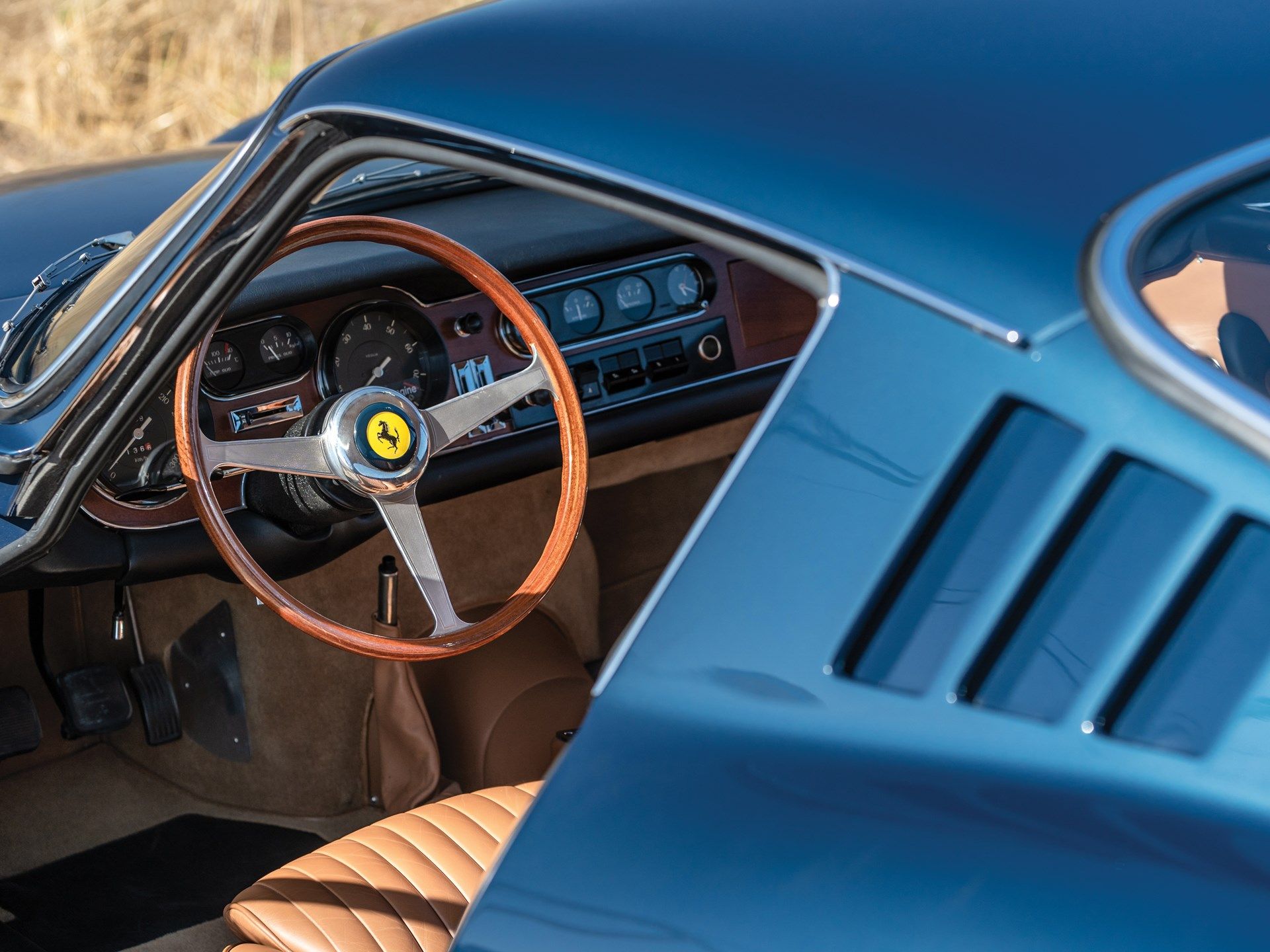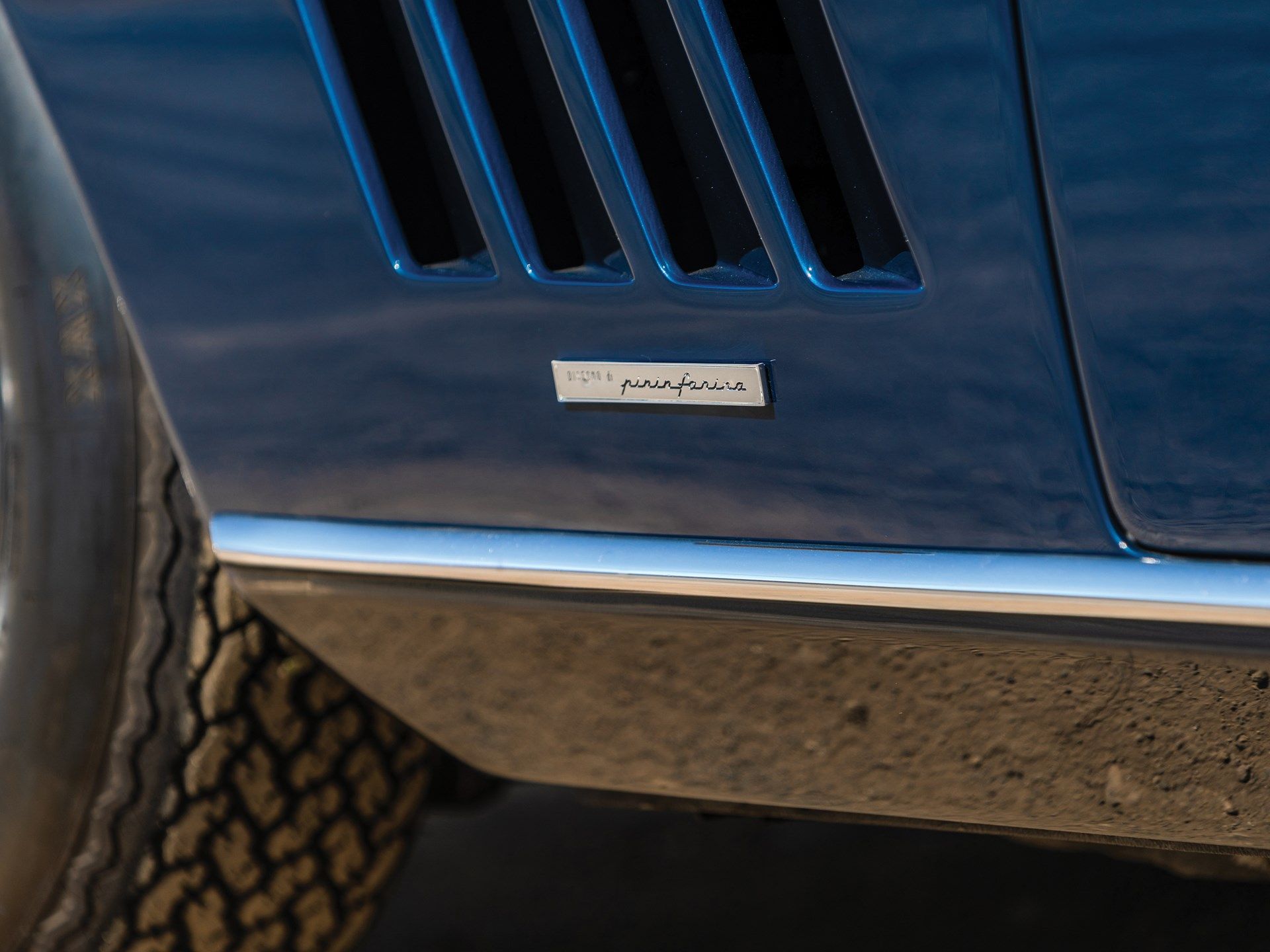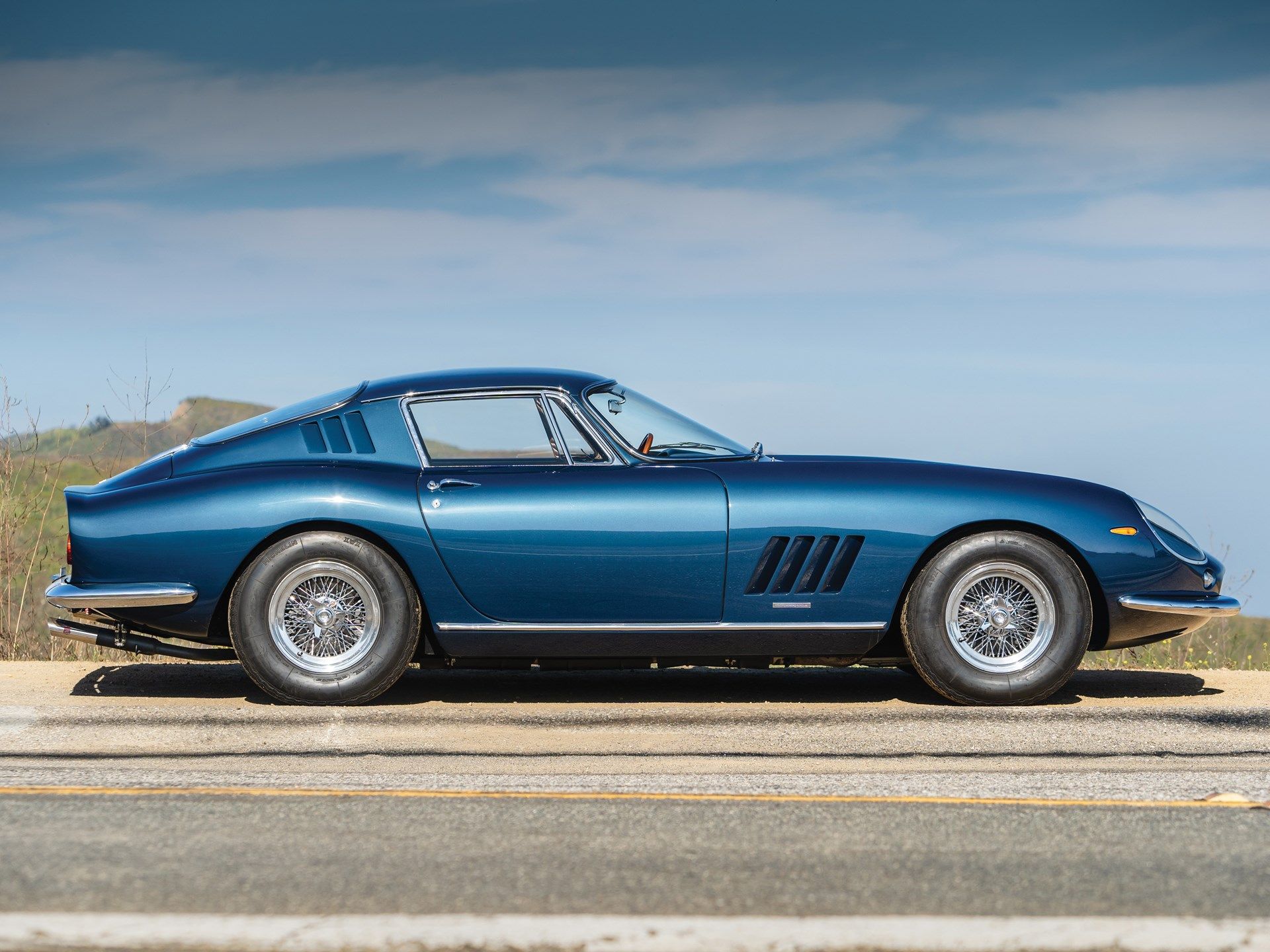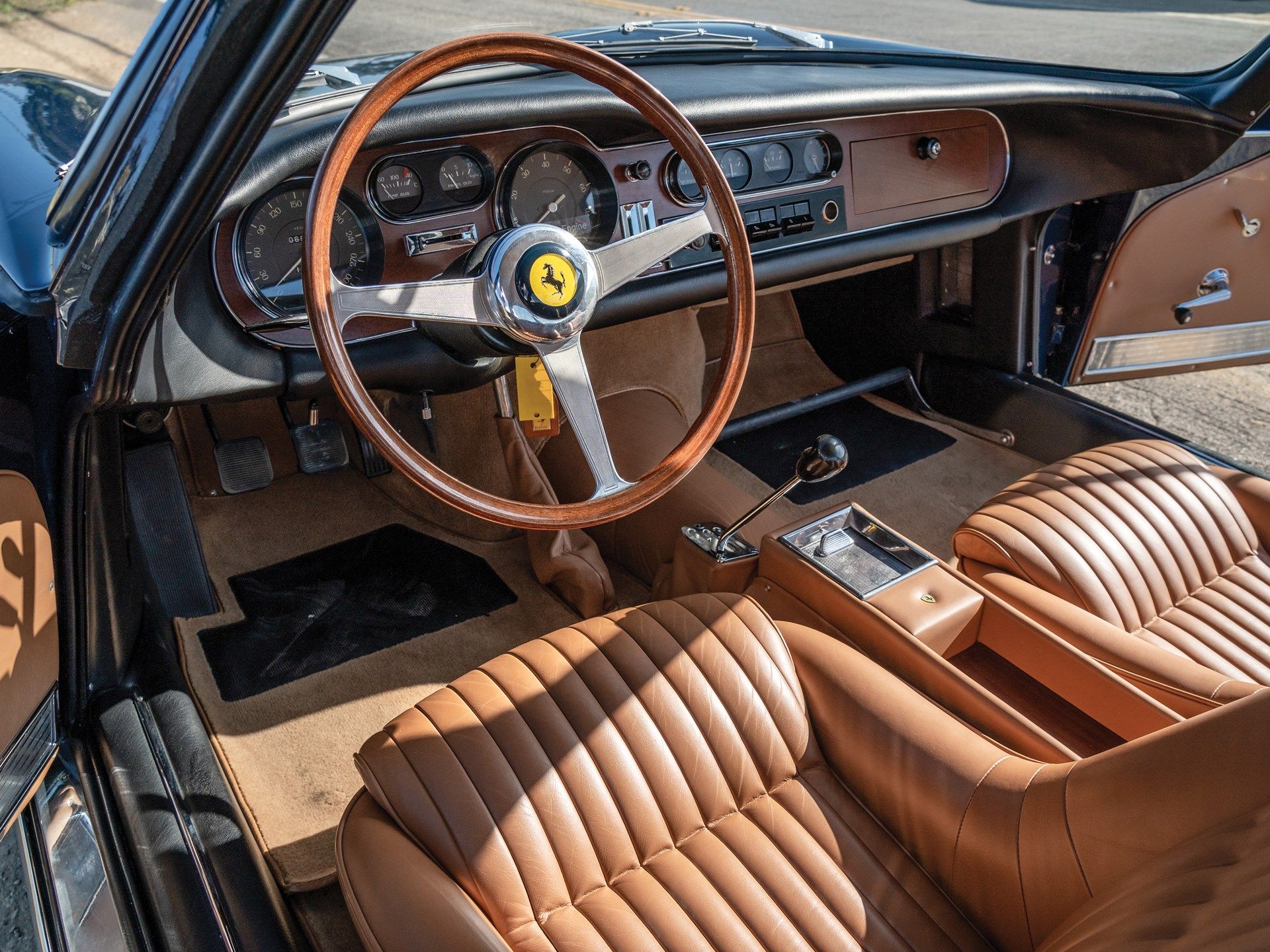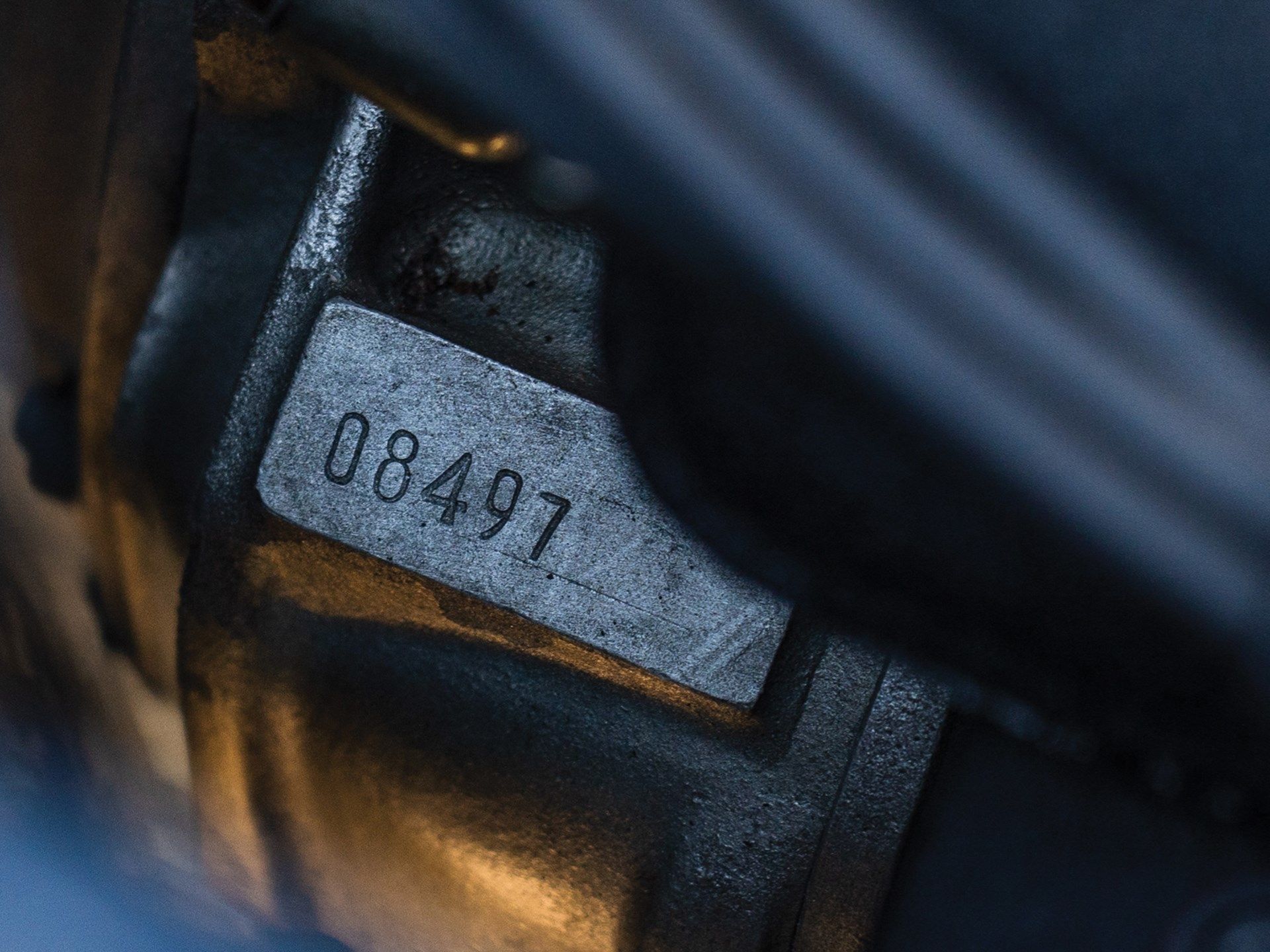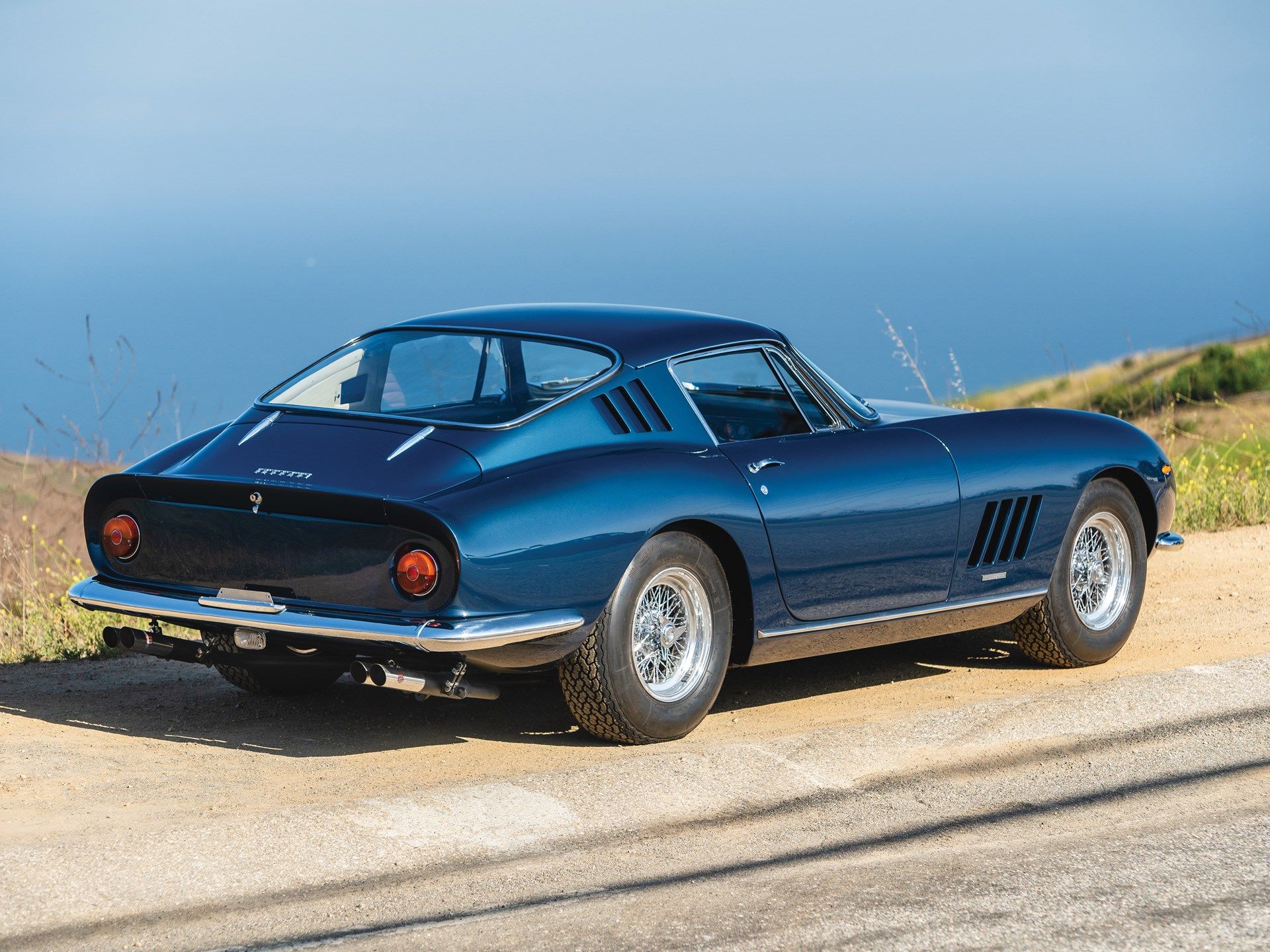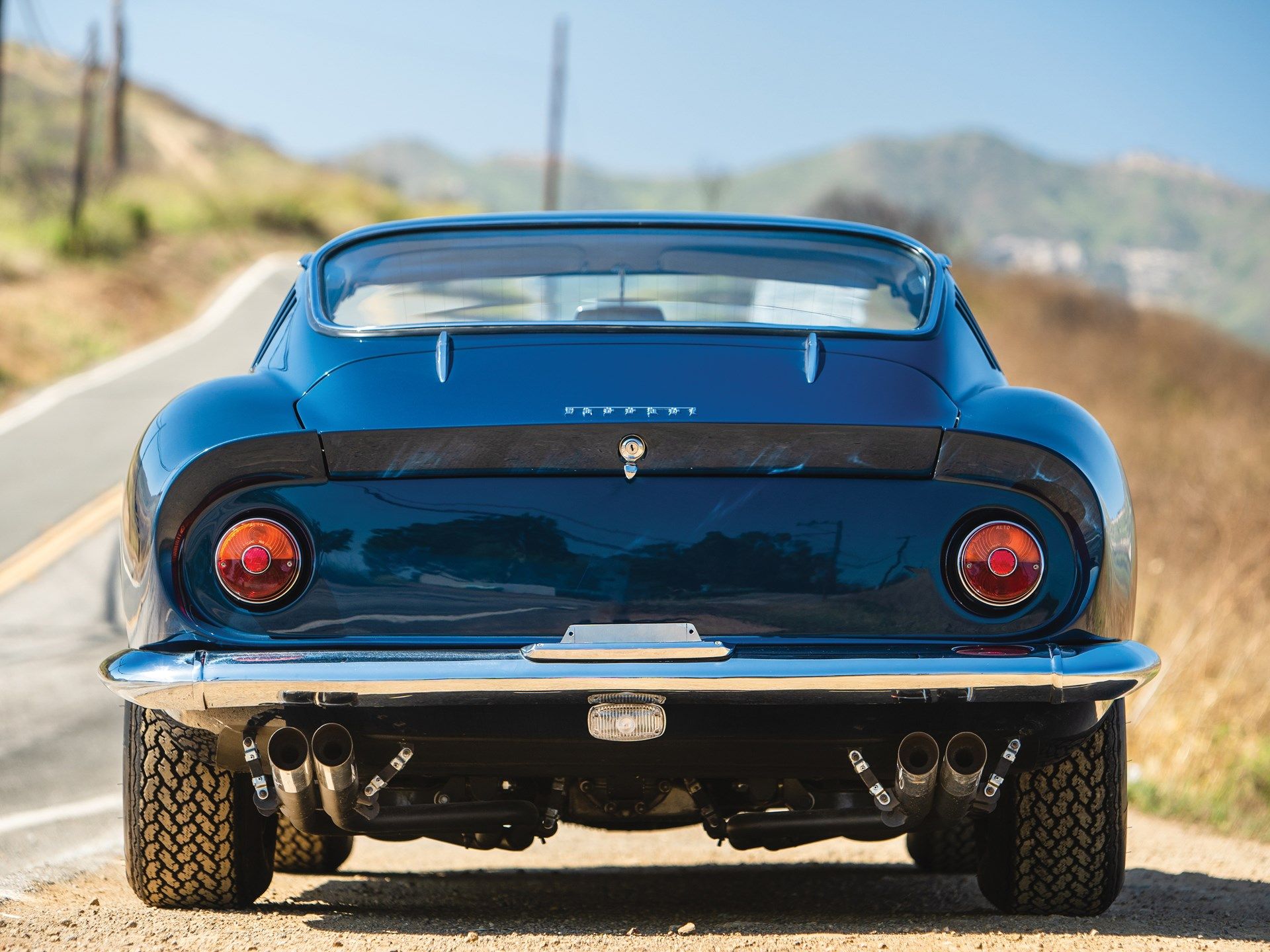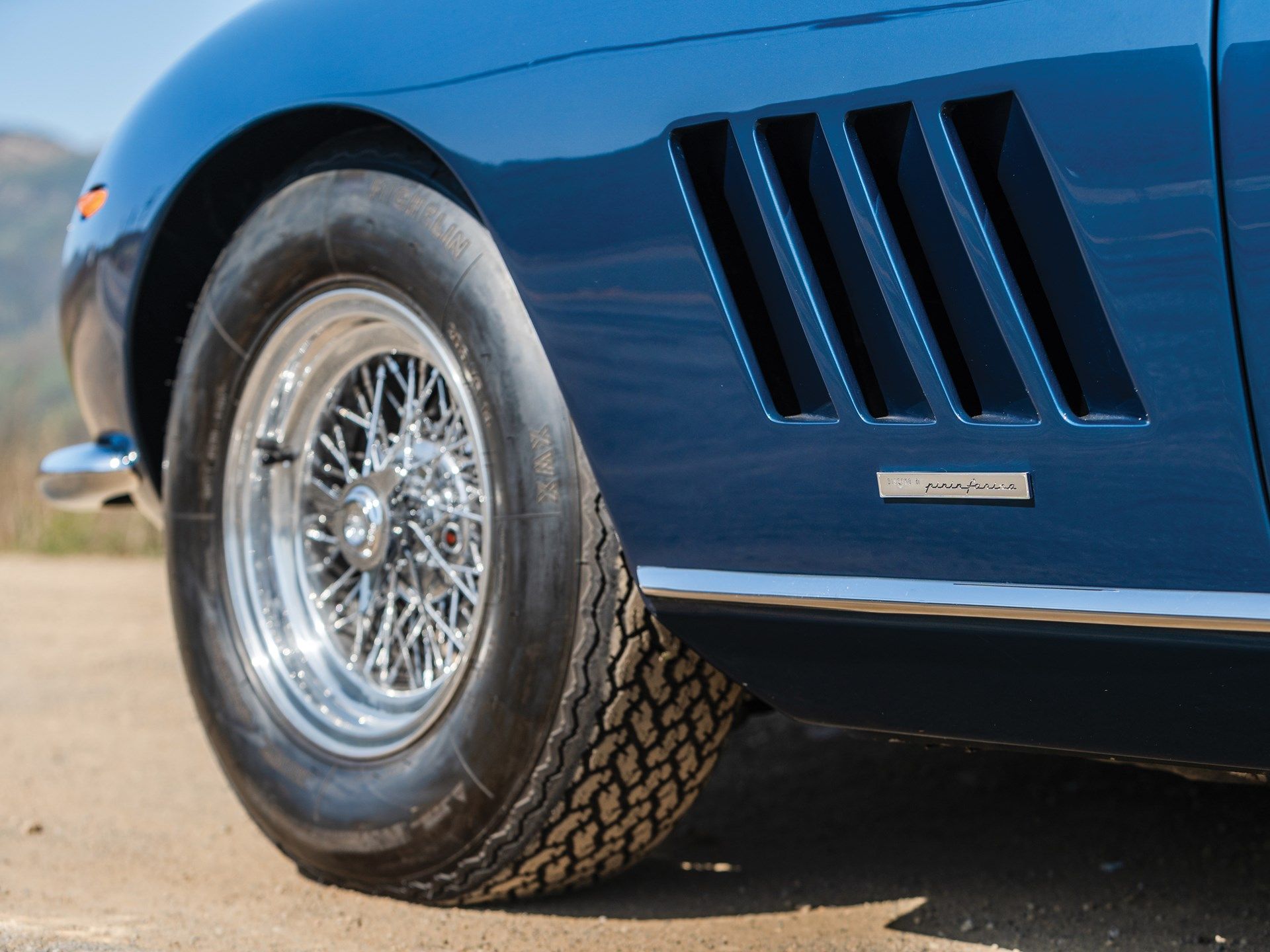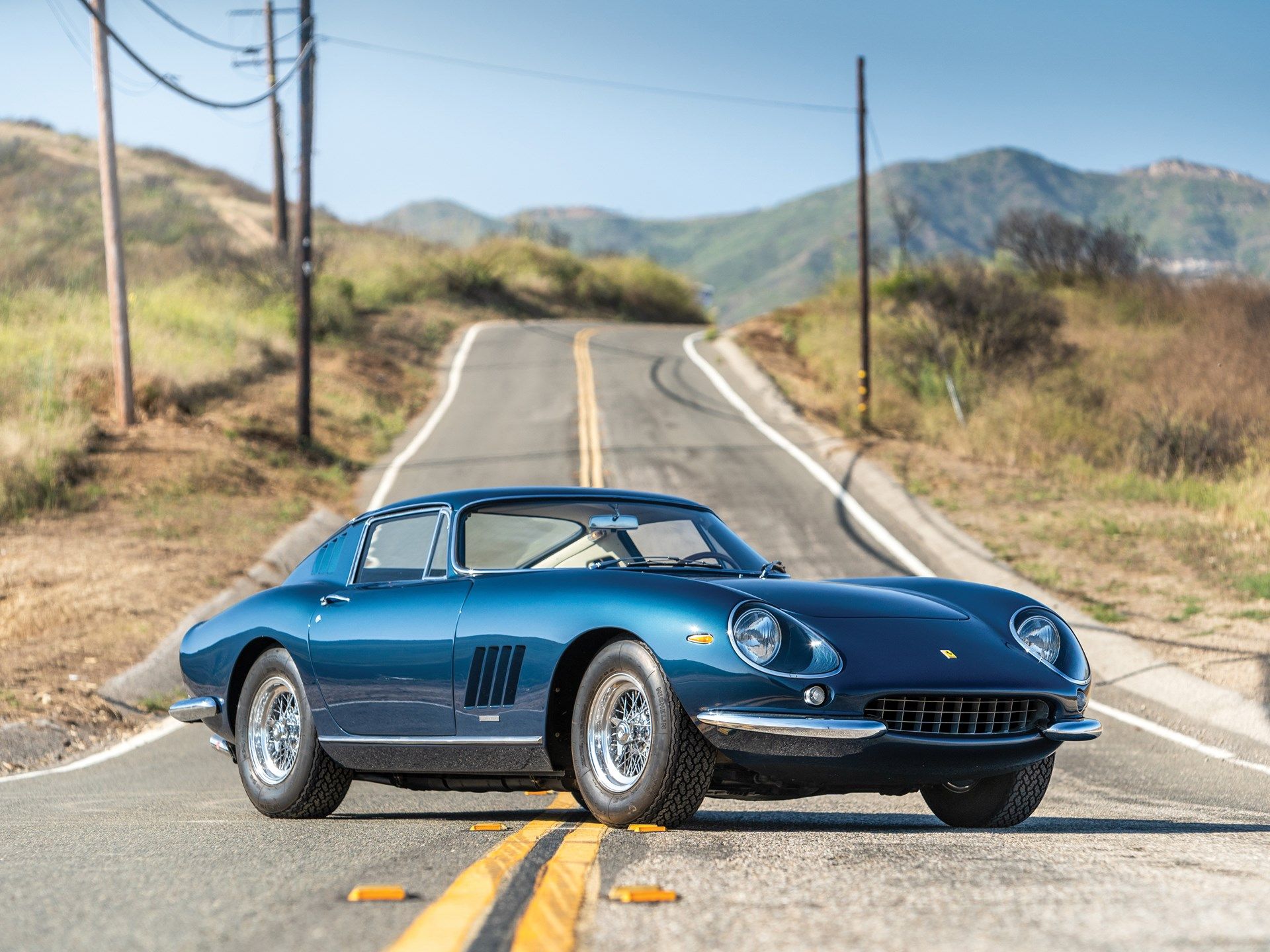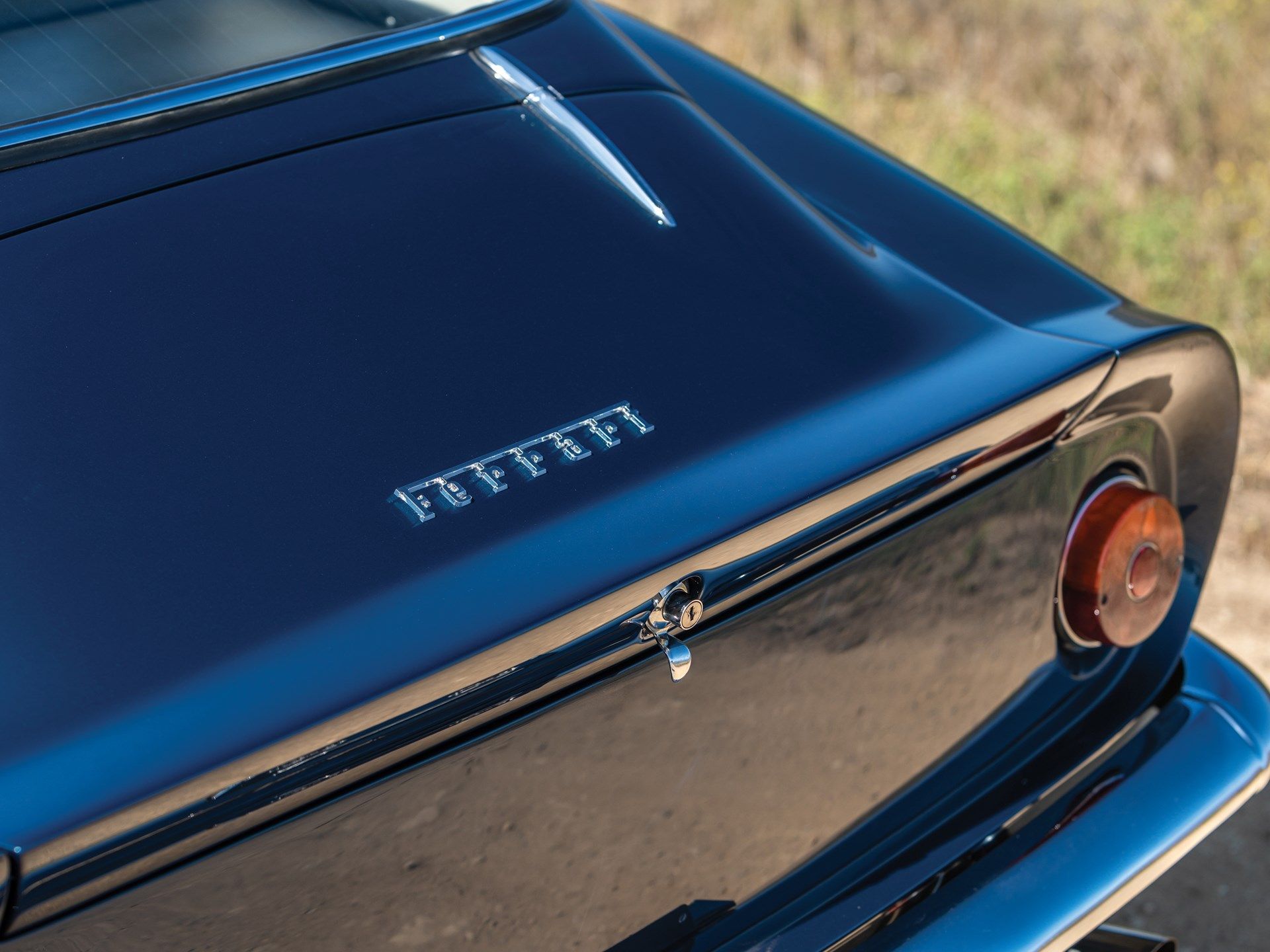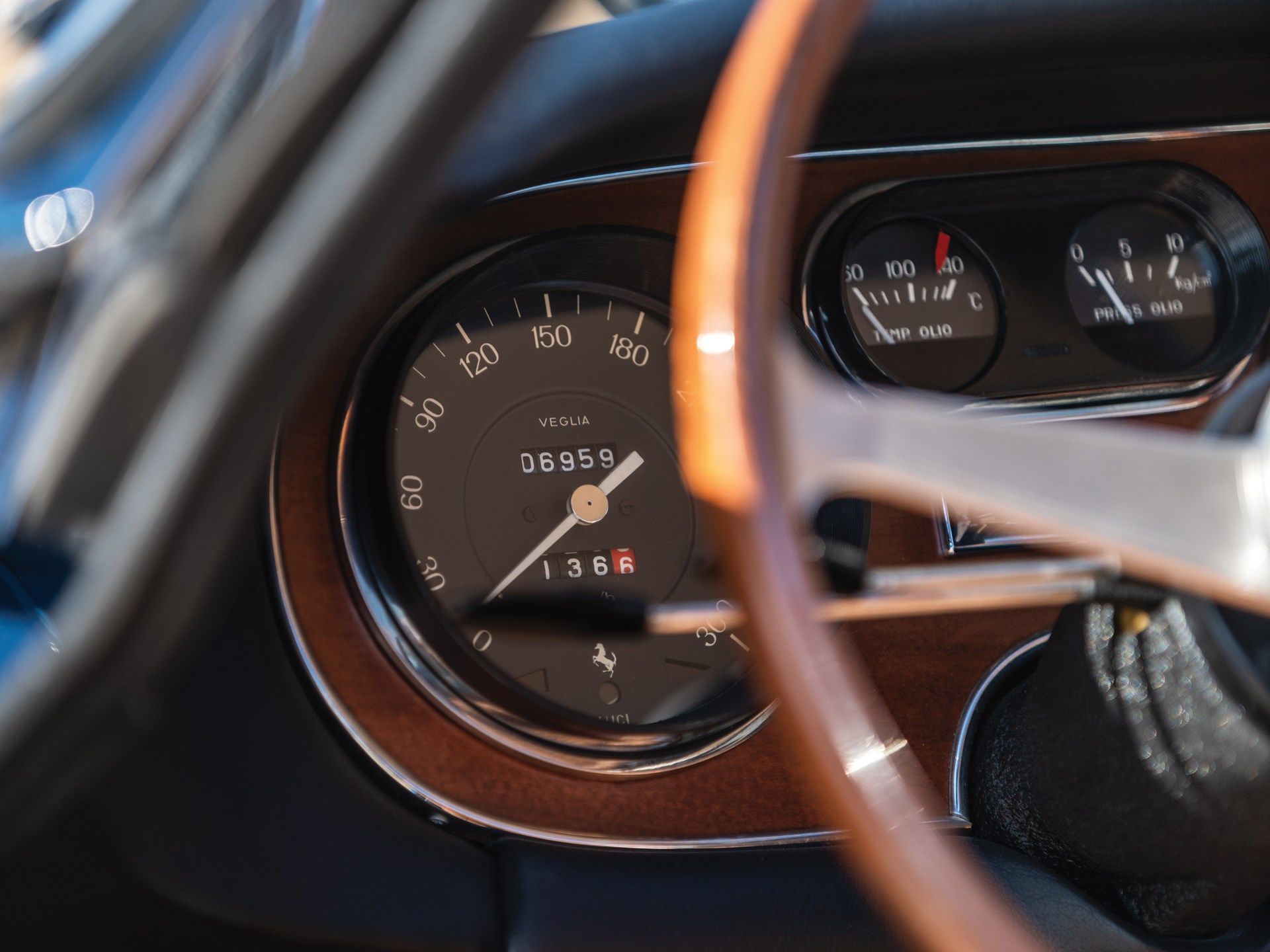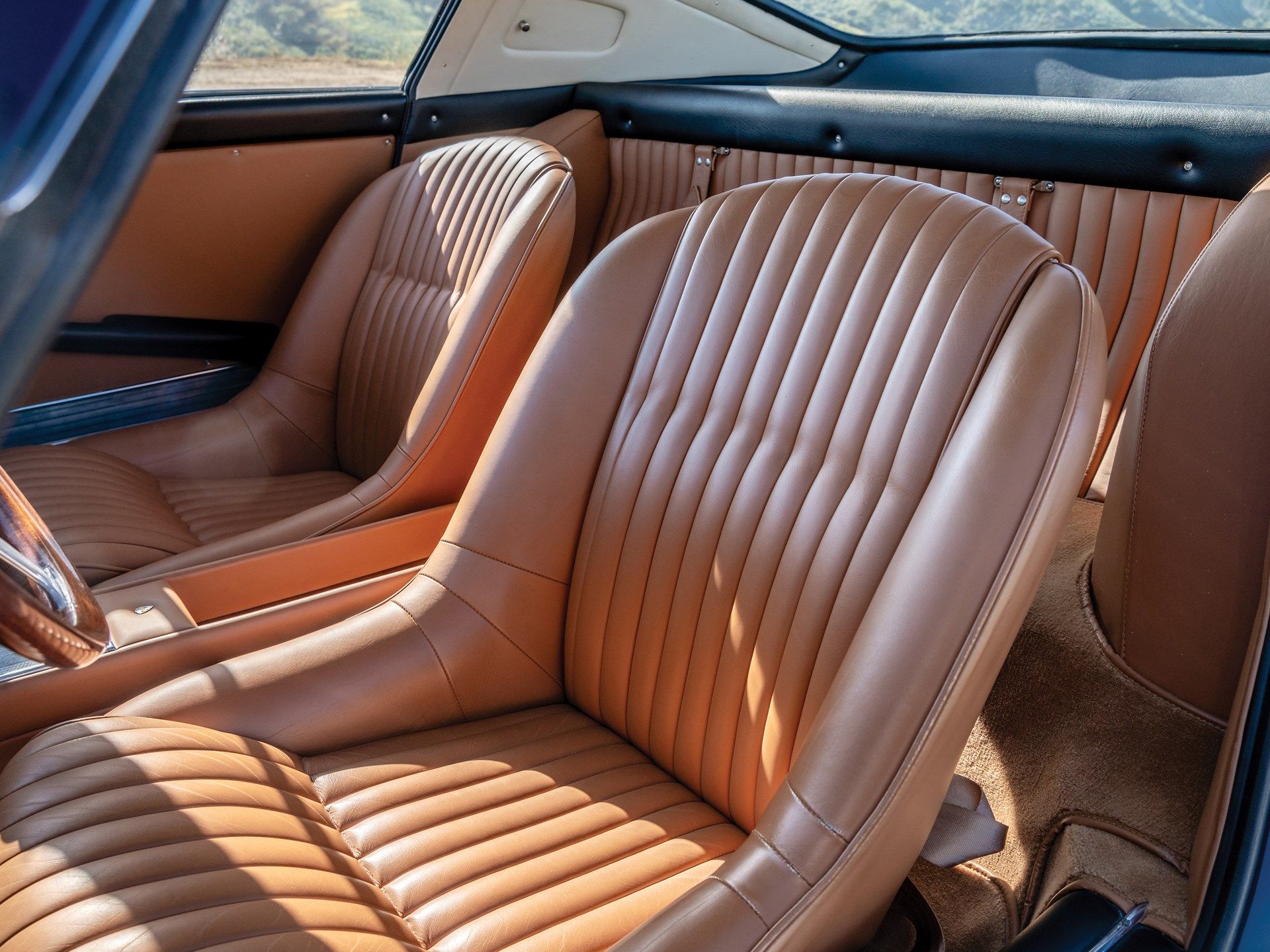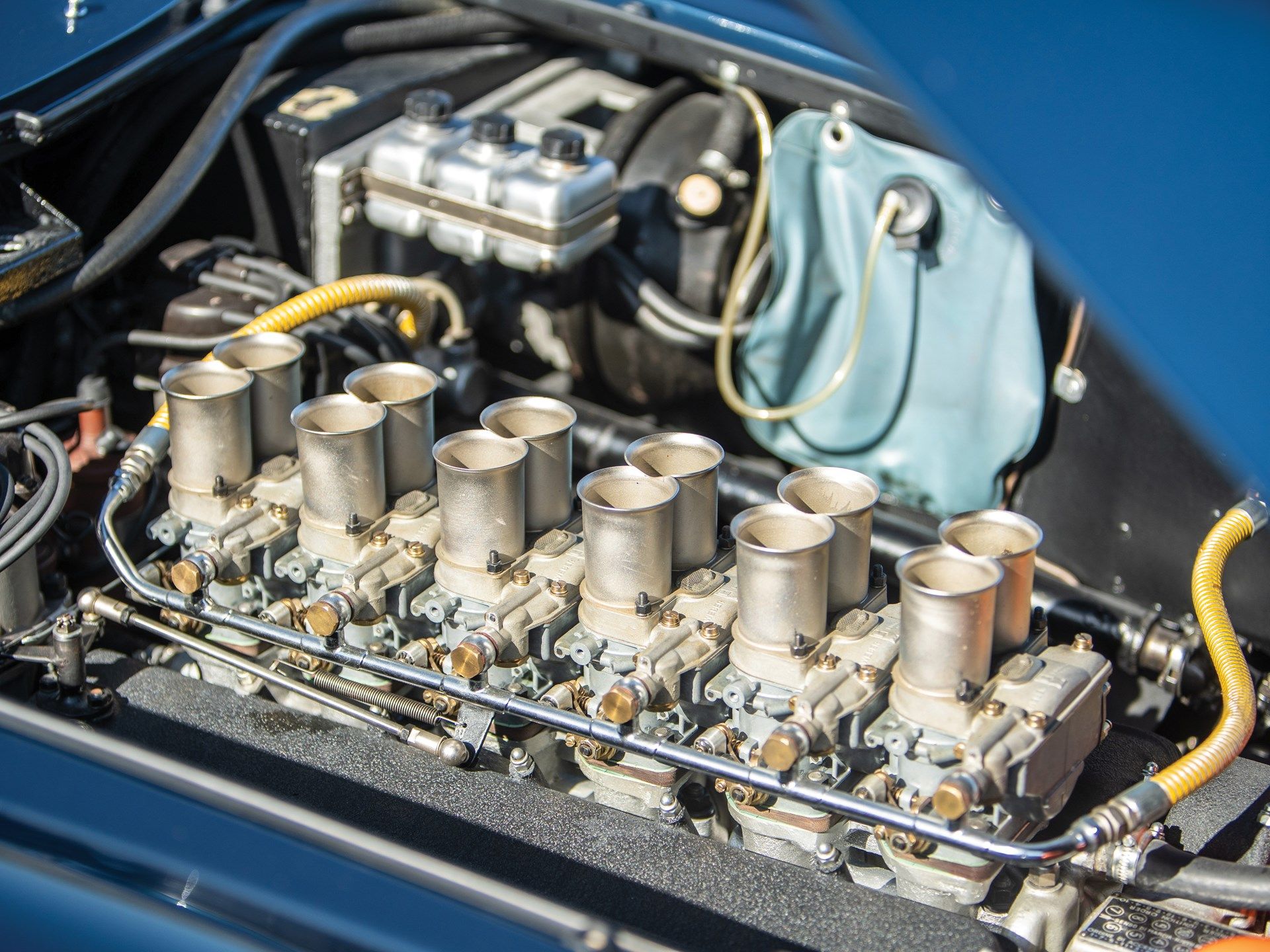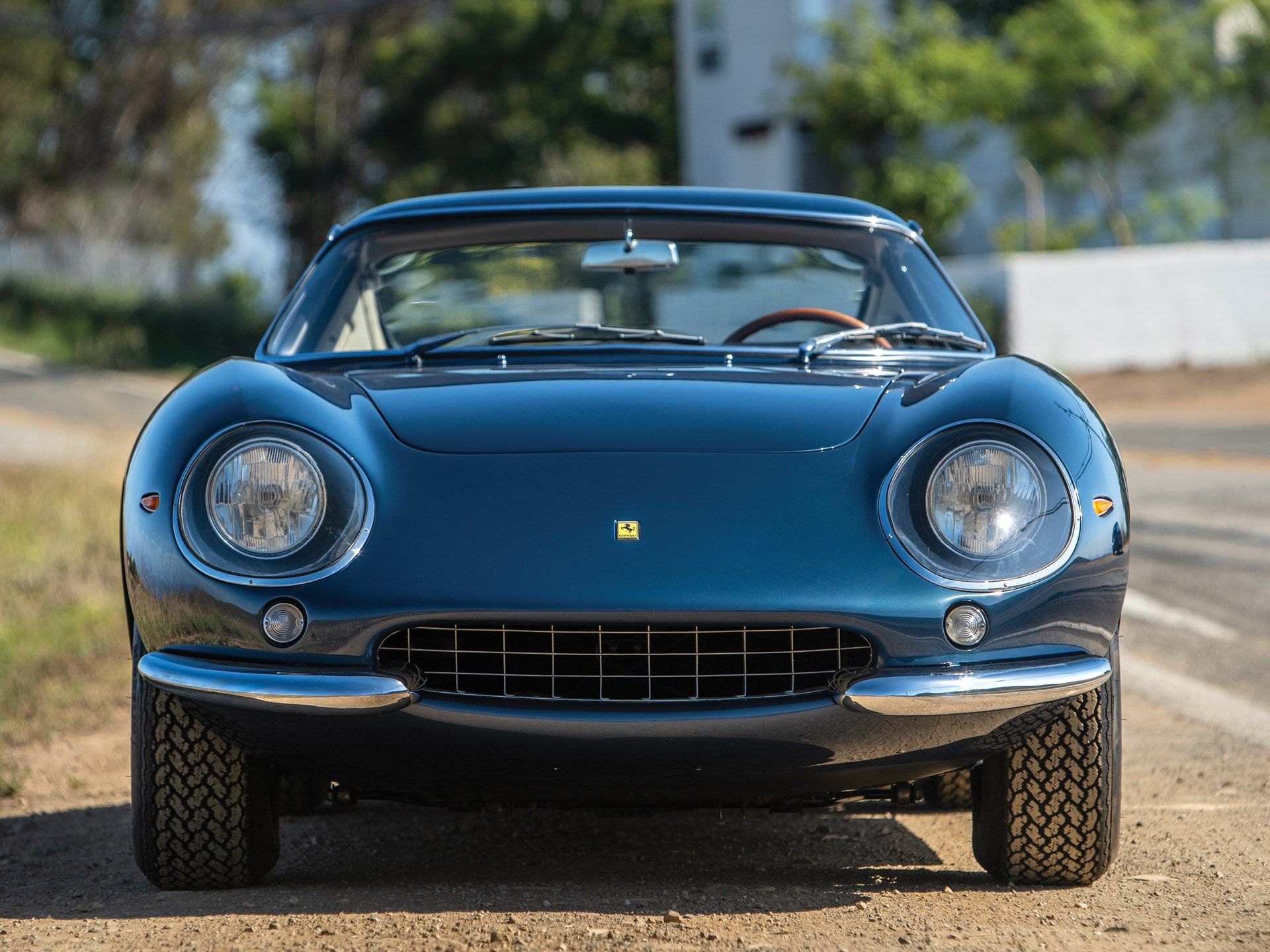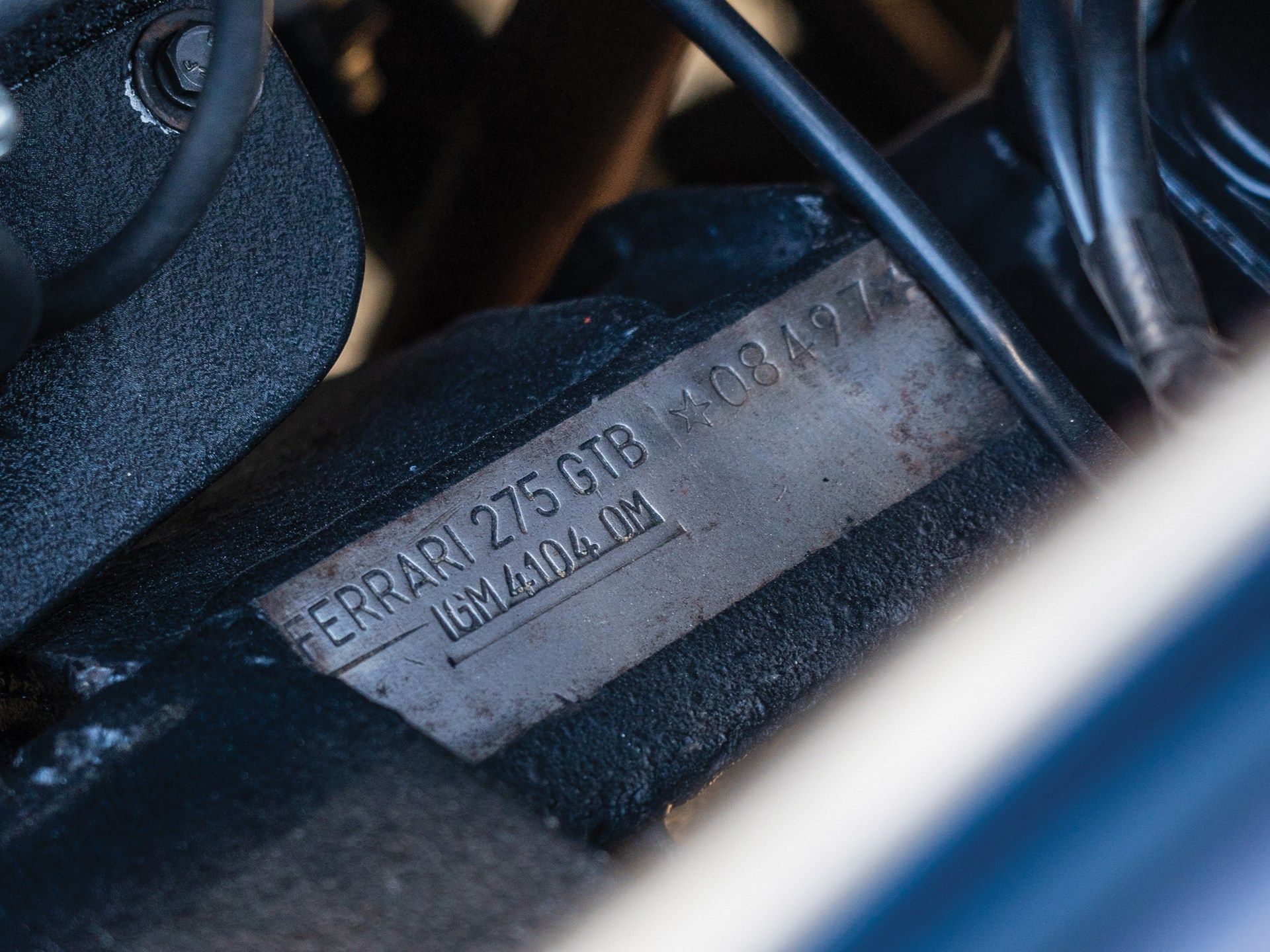The Ferrari 275 GTB is widely considered to be one of the prettiest grand touring cars built during the sizzling '60s. Displaying an evolutionary design language influenced by Ferrari's glorious 250-series models such as the 250 GTO and the 250 GTE 2+2, the 275 GTB came in both short-nose and long-nose specification, with the 3.3-liter Colombo V-12 first featuring two overhead camshafts before Ferrari introduced, in 1967, the 275 GTB/4 with four overhead camshafts. This here is a Series II 275 GTB or, in other words, a long-nosed version built towards the end of the GTB's production run in 1966. It's one of the last of just a few dozen 275 GTBs with an all-aluminum body shell that makes the car both lighter and rust-proof. Too bad it's as expensive as a handful of Ferrari F40s.
Even fans of modern supercars and wedge-shaped obscurities from the '80s would oftentimes come together and agree that the GTs made in the '60s are a sight to behold: elongated noses, low rooflines, and a tail that usually ends with a stubby Kammback. It's a well-known recipe and few applied it better than Ferrari. Designed by the house of Pininfarina, by now an integral part of the Maranello-based manufacturer, the 275 GTB came to sweepingly replace all of the 250-series models. It was designed to be more user-friendly, more practical, but without giving up on performance or the unique feeling of being behind the wheel of a Ferrari. Included by many publications on shortlists of the prettiest Ferraris of all time, the 275 GTB was also a successful race car and it also spawned an open-top version in the N.A.R.T.-commissioned 275 GTS/4 Spyders built between 1967 and 1968 (the 275 GTS featured a completely different Pininfarina body while the N.A.R.T. cars featured Scaglietti bodies in the style of Pininfarina's Berlinetta design).
1966 Ferrari 275 GTB Alloy by Scaglietti
- Make: Array
- Model: 1966 Ferrari 275 GTB Alloy by Scaglietti
- [do not use] Vehicle Model: Array
1966 Ferrari 275 GTB Alloy by Scaglietti Exterior
Ferrari in the '60s wasn't a company that liked change. The Ferrari 250 platform (250 refers to the individual capacity of each cylinder) had been in use since the '50s and, by the dawn of the '60s, Ferrari was still pumping out 250-based GTs: the 250 GT Interim was introduced in 1959 featuring the new Pininfarina-designed body shells to be used on the upcoming short-wheelbase Berlinettas, albeit fitted to long-wheelbase 250 GT chassis.
The gorgeous and, nowadays, extremely expensive (surpassing even the prices of 250 GT SWBs) 250 GT SWB California Spyder was introduced in 1960 with a 94.5-inch wheelbase, identical to the wheelbase of the fixed-head SWB. The V-12-engined SWB was the car of choice of a number of notable celebrities at the time including James Coburn and Alain Delon and is considered to be prettier than the 250 GT LWB Spyder. Around that same time, Ferrari also cranked production numbers at the Maranello plant after introducing the 250 GT/E 2+2, the brand's first four-seater that would not be made in ultra-small numbers. On the back of the 250 GT/E's success, Ferrari was able to develop the GT SWB's successor for the 1962 racing season.
Built with a clear intent to challenge Jaguar and the rest of the known culprits in the World Endurance Championship, the 250 GT Omologato swept the floor right out of the box. That same year, people that didn't want the aggressive and track-oriented GTO could go for the GT 'Lusso' (a name also used when referring to the 250 GT SWBs built for street use rather than racing). The Lusso the last model of the 250 series and was based on the SWB's chassis although it wasn't tuned for racing. The gorgeous cues had, as ever, Pininfarina's fingerprints all over them and Steve McQueen was one of the prominent owners, receiving chassis #4891 from then-wife Neile Adams as a gift. It sold years later for over $2.3 million at auction.
The 250 GT Lusso, recipient of the prettiest front bumpers ever, as well as a svelte and elegant roofline, was, legend has it, discontinued because Enzo Ferrari reckoned it didn't look aggressive enough to properly evoke Ferrari's image as a maker of fast, race-bred, road cars.
The car people saw at Europe's most important auto shows, such as the Paris Motor Show (where the 275 GTB was introduced), the Turin Motor Show, or the Frankfurt Motor Show was chassis #06437. It was the second chassis received by Pininfarina during the developmental stage of the 275 GTB and it became, for a short while, the personal car of Battista Pininfarina, the company's founder.
As the only 275 GTB built from the ground up by Pininfarina (all others, be it with a steel body or an aluminum one would be built by Carrozzeria Scaglietti), it's special and features the standard 14-inch magnesium wheels and the short-nose setup. It sold for over $8 million at auction last year but can still be considered cheap when you take into account that any of the 10 N.A.R.T. Spyder is worth over $20 million.
From the front, the 275 GTB looks like it means business with the horizontally mounted, oval intake with its egg-crate grille. The intake is guarded on either side by the curved and chromed bumpers that go around the corners of the front overhangs. Above the bumpers there are the clear glass road lights and the headlights, one headlamp pushed far back into the nose on either side. The rectangular Ferrari badge is located in between the headlights with the indicators placed on the sides of the nose.
The fenders are taller than the hood and feature a slight crease, their height being dictated by the tires used on the 275 GTB. While Pininfarina's GTB sports a bulge on the hood to clear the Weber carbs, production GTBs lack it. While the aluminum body panels are smooth and attract the eyes due to how curvy they are, it's worth mentioning that building the alloy-bodied cars was a laborious affair carried out mostly by hand and, as such, no car is identical. Basically, craftsmen would beat the panels, placed on body bucks, into shape using hammers just like they did in the case of the 250 GTO and other cars from that era. This is why alloy cars are significantly rarer, the cost attached to the whole operation adding a significant premium to an already expensive MSRP of over $8,000 in 1966 (or $63,347 today).
Below the door line, a chromed bar extends between the wheels as a stylish link between the front and rear bumpers. A small, rectangular Pininfarina badge placed below the four vents on the side reminds eagle-eyed onlookers of the design firm responsible for this beauty. A 275 GTB is just 49 inches tall, little over an inch lower than the Ferrari 812 Superfast, the current flag-bearer for front-engine Prancing Horses.
In the back, you'll quickly spot how the rear center panel is actually pushed in compared to the edge of the tail. In between the two round taillights (that are divided in two with the indicators in the top half), there's plenty of room for a number plate. A tiny prancing horse can be seen on the chromed handle that releases the latch holding in place the trunk lid. The light that illuminates the number plate is attached to the wraparound rear bumper. Also attached to the bumper is a reverse light.
Due to the angle of the rear window, visibility in the back is limited. In the front, however, you can see a bit more due to the wraparound windshield although it too is positioned at an angle and, with the low roofline, you don't really see that much considering how much hood there is right smack in front of you. Another thing you don't see from the outside is that the exposed trunk lid hinges, a beautiful add-on to the Series II models, actually steals some luggage space.
1966 Ferrari 275 GTB Alloy by Scaglietti exterior dimensions
|
Length |
170.3 in |
|---|---|
|
Width |
67.9 in |
|
Height |
49 in |
|
Wheelbase |
94.5 in |
1966 Ferrari 275 GTB Alloy by Scaglietti Interior
The interior of a Ferrari 275 GTB is full of delicious details that require hours to soak in. From the leather dash with a wooden center panel outlined by a chromed frame to the elegant polished Ferrari wheel with a wooden rim and the lavish beige leather bucket seats, it's almost too pretty use - but you have to if you want to enjoy the car. As you step inside you're greeted by the three-spoked wheel, a well-known sight in any '50s and '60s Ferrari.
There's no center console as such and the gated shifter with its chromed lever (the knob is black and the gate itself is chromed too) comes straight up from the floor, positioned to the left of the transmission tunnel. The ashtray is placed in the middle in front of a longitudinal storing area between the seats.
1966 Ferrari 275 GTB Alloy by Scaglietti Drivetrain
The Ferrari 275 GTB was meant to be more poised and focused than the long-legged 250 GT Lusso. In spite of that, at first, it only received a two-cam version of Colombo's V-12 bored out to 3.3-liters - just as big as the V-12 in the 250 LM (or, rather, 275 LM) racing car. Known as Tipo 213, the SOHC (the quad-cam/DOHC engine in the 275 GTB/4 is known as Tipo 226) engine was good for 280 horsepower at 7,800 rpm and 215 torques at 6,000 rpm. This may not seem like much in 2019 when the not-so-new 812 Superfast with its 6.5-liter naturally aspirated F140 GA V-12 blasts to the horizon with 789 horsepower at its disposal but, in 1965, 280 horsepower was quite something.
Due to the repositioning of the gearbox, the engine could be moved more towards the middle of the car improving the weight balance and lowering the center of gravity. Behind those Borrani spokes you'd find 11-inch Dunlop discs in the front and 10.8-inch Dunlop discs in the rear. While the brakes are responsive, they were seen back then as inadequate on out-and-out performance cars due to their tendency to overheat if leaned upon heavily for a longer period of time as they weren't ventilated nor too big in diameter. The brakes hid Koni shocks and coil springs.
Steering was by worm and roller and is precise with the suspension just firm enough to offer a reassuring ride that's not wobbly in the turns. It helps also that the alloy-bodied cars were significantly lighter than steel-bodied ones (some 400 pounds down on a standard car that already featured aluminum doors, trunk lid, and hood).
Ferrari introduced the 275 GTB/4 in 1966 at the Paris Motor Show as a response to the four-cam Lamborghinis of the day and, with the TIpo 226 onboard, the 275 GTB was taken to new heights.
Upon release, even the SOHC 275 GTB was met with rave reviews, Autosport from the U.K. saying about the six-carb model it tested that it's "a car so good it comes close to perfection," while America’s Sports Car Graphic labeled it as a car meant "strictly for the connoisseur." Indeed, you had to know what you were doing in a car that could reach almost 160 mph with three carbs and exceed that with six carbs while also going from naught to 60 mph in six seconds flat but it didn't feel threatening, down to the "ideal" pedal arrangement that made heel-and-toeing easy.
1966 Ferrari 275 GTB Alloy by Scaglietti specifications
|
Engine |
3.3-liter, naturally aspirated, wet-sump, twin-cam, Tipo 213 V-12 |
|---|---|
|
Bore x stroke |
3.03 X 2.31 inches |
|
Fuel feed |
Three or Six Weber 40DCN9 17 carburetors |
|
Compression ratio |
9.2:1 |
|
Output |
280 horsepower at 7,800 rpm |
|
Torque |
215 pound-feet of torque at 6,000 rpm |
|
Suspension |
Independent all around with double wishbones, Koni shock absorbers, and coil springs |
|
Steering |
Worm and roller |
|
Brakes |
Dunlop discs all around, 11 inches in diameter in the front and 10.8 inches in diameter in the rear |
|
Performance 0-60 mph |
6 seconds |
|
Top speed |
160 mph (six-carb version) |
|
Weight |
2,466 pounds (alloy body) |
1966 Ferrari 275 GTB Alloy by Scaglietti Prices
Prices have only gone up for the 275 GTB but this is also true for all of Ferrari's legends from the past.
As mentioned, Battista Pininfarina's unique 275 GTB sold for $8 million and any N.A.R.T. Spyder fetches 250 GT SWB money, so you can count yourself lucky if you can get one for under $3 million - RM/Sotheby's sold one during its Amelia Island event for just $2.2 million but it was a short nose example with a steel body.
If you want similar amounts of power from an Italian grand tourer and aren't yet ready to pay the price of nine brand-new F8 Tributos, you can recalibrate your attention and look for a Lamborghini 350 GT. The first production Lamborghini is rare too with only 120 examples assembled by Carrozzeria Touring and it looks quirky. More importantly, you can get one for under $600,000.
The car was first painted in white (Bianco Polo) over black leather and spent its first few years in Italy before being sold off and freighted across the Atlantic. It returned to Europe after a 16-year American adventure still featuring the original paint job. The Swiss owner that brought it back to Europe in 1989 later sold it to an Italian collector based on Bergamo, where the car had resided back in the early '70s. Then, it was bought by a Swedish gentleman who repainted it in the color we see today. Shown at the 2010 Concorso d'Eleganza Villa D'Este, the car received the Classiche Certification from Ferrari proving that it's a numbers-matching example around this time before returning to American soil in 2014 which is where it resided until being sold through RM/Sotheby's during the Monterey event in August.
1966 Ferrari 275 GTB Alloy by Scaglietti Competition
1964 Lamborghini 350 GT
The 350 GT was the result of Ferruccio Lamborghini's poor experiences in owning 250-series Ferraris. Displeased by the treatment he received when meeting Enzo Ferrari himself to discuss the shortcomings of his cars, Lamborghini vowed to create a grand tourer that would beat Ferrari at its own game. As a prolific industrialist, Lamborghini afforded to hire ex-Ferrari engineer Giotto Bizzarrini to design for him a car and the man behind the 250 GTO came up with the 350 GTV.
That car morphed into the 350 GT after Bizzarrini's departure and the hiring of Paolo Stanzani and Gian Paolo Dallara as replacements. The original 400 horsepower 3.5-liter, DOHC, aluminum V-12 said to produce 400 horsepower at 11,000 rpm on the bank was detuned for both safety and reliability reasons to produce 280 horsepower and 240 pound-feet of torque. The power reached the back wheels via a ZF-sourced five-speed manual.
The 350 GT as redesigned by Stanzani and Dallara was shown to the public at the 1964 Geneva Motor Show and was put into production shortly thereafter. Carrozzeria Touring carried out the assembly process using the patented Superleggera method of construction to fix aluminum alloy panels directly to a tubular structure. All 350 GTs featured all-independent suspension and Girling discs at all four corners and, on a good day, a 350 GT could reach 158 mph meaning it was a match for the 275 GTB. The car looked stranger with its rectangular headlights and bulbous cabin that led to a low tail section and this is maybe why it didn't really sell too well. This and the fact that interior space was limited which is why the 350 GT was duly replaced by the 400 GT, a bigger model that could seat four people on paper.
Read our full review on the 1964 Lamborghini 350 GT
1964 Jaguar E-Type Series I
While one could say the Aston Martin DB5 would be a more appropriate rival to the 275 GTB due to the fact that the Aston was a more upmarket option compared to the E-Type, we chose the E-Type as a way to illustrate what you could do if you couldn't quite afford a Ferrari grand tourer in the mid-'60s but still wanted something that followed the same ethos. The Series I E-Type is the prettiest of the lot with its covered headlights and low roofline as well as the taillights placed above the thin rear bumper, not below like in the case of the butchered Series IIII examples.
Penned by none other than Malcolm Sayer, designer of the C-Type and D-Type racing sports cars, the E-Type initially came with the 3.8-liter straight-six from the XK150. This engine is the reason behind E-Type's long hood. The powerplant's capacity was increased to 6.4-liters in 1964 but power stayed put at 265 horsepower although max torque went up to 283 pound-feet. 0-60 mph was achieved in under 6.5 seconds, respectable for a car that weighed almost 500 pounds more than the alloy-bodied 275 GTB and was also down on power.
Autocar reached 153 mph aboard an S1 E-Type fitted with the 4.2-liter engine and concluded that "in its 4.2 guise, the E-Type is a fast car (the fastest we have ever tested) and offers just about the easiest way to travel quickly by road." Like its Italian peers, the Jaguar came with disc brakes all around (but this was to be expected since Jaguar was the automaker that championed the use of disc brakes over drums in motorsport as early as 1953) and independent coil spring rear suspension with torsion bars in the front. While cheaper than an Italian GT car, the E-Type still featured leather-wrapped bucket seats and dashboard (where leather was wrapped with vinyl from '63 onwards) and, like in the case of the Ferrari, wire wheels were optional but most customers went with this stylish choice.
Read our full review on the 1964 Jaguar E-Type Series I
Conclusion
The Ferrari 275 GTB is one of the best looking cars to come out of the '60s and one of the prettiest Ferraris which is no mean feat considering what utter jewels came out of Maranello only during that decade that saw the unveiling of the 250 GT SWB, the 250 GT SWB California Spider, and the 250 GTO among others. In such an exquisite company the 275 GTB stands on its own two feet as a car that is inspired by what came before it while also encapsulating enough technical advancements to make it a step forward in every area.
It's predictable to drive and, once you've learned its moves, quite easy to steer for a +50-year-old machine with almost 300 ponies at the command of the loud pedal. This means it can be driven - and begs to! - on a twisty road without worrying you'll end up in a ditch or ravine and it also takes highways in its stride as if it's nothing. Hitting the 7,800 rpm redline produces an aural pleasure that's tough to put into words and we couldn't fault you for wanting this car for the sound it makes alone. Add to the aural nirvana that the gorgeous body, the tasteful interior, and the way it carries itself as a sports car and you end up with a package that's hard to beat, even 55 years after it was first revealed to the wide-eyed public.
Further reading
1966 Ferrari 275 GTB Prototype That Raced In The Monte Carlo Rally
Read our full review on the 1967 Ferrari 275 GTB/4S N.A.R.T. Spyder

